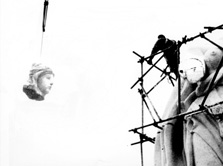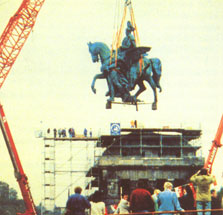
und sahen, was zu machen war...
Stephan Sachs
1991-1994 | 16mm | 72 Min
Menschen bei der Arbeit. Bei großer Hitze schwitzen sie für ein Stück deutscher Geschichte. Sie schwitzen für ein Denkmal. Ein Filmessay über die Montage und Demontage der deutschen Vergangenheit und ihrer Symbole.
Texte
und sahen, was zu machen war...
Johannes C. Tritschler | Journal Film n° 28 | 1994/95 | de
Ein Kaiser wird rekonstruiert
Hartmut W. Redottée | Kino Kommunale | 1995 | de
Geschichtsbilder
Dr. Eva Hohenberger | Filmdienst 1/95 | 1995 | de
Ausschnitt aus "Portrait Stephan Sachs"
Veronika Rall | epd Film 11/94 | 1994 | de
Presseartikel zu "und sahen, was zu machen war..." | de
Pressezitate zu "und sahen, was zu machen war..."
| de/en
and saw, what should be done...
Stephan Sachs
1991-1994 | 16mm | 72 min
January 1991. At that time the 'clean TV war' in the Gulf sensitized me to the inexorable relation between images and power. By coincidence I found myself in a bronze foundry in Dusseldorf. My curiosity was roused by two enormous, classicist woman's legs rising to the roof. They were part of a reconstruction of an equestrian statue of Kaiser Wilhelm originally erected in 1897. A goddess of victory carries the crown ahead of the Emperor. The ruling powers of the Third Reich were quick to exploit the ideologies inherent in the statue. The Allied forces deliberately shot it off its base in 1945. The fact that this male fantasy of superpowerdom from the days of Prussian militarism was to be re-erected shortly after the latest German reunification epitomized for me a very contemporary way of dealing with history and its images.
The actual reconstruction of the statue, which is 45 feet high, runs like a thread through the film And saw what should be done (72 min 1991-94). The complex process necessary for the production of such a monumental statue consists of a continual putting together and taking apart. The film makes use of this principle, which is very much like cinema's montage principle. By the time we witness the celebrations for the statue's inauguration, its filmic 'de-montage' is a fait accompli. Like a mosaic, associations of historical images gradually intertwine with the work process and historical material. Whereas the start of the film, showing the work on the polystyrene, still evokes the idyll of art, the scenes covering the forging of the 'everlasting' metal touch upon the darkest chapters of German history. Yet the film's ending is not a dark one. It depicts the grotesque ambiguity of political, warm-hearted, and ultimately touristic handling of history.
texts
And Saw What Should Be Done
Stephan Sachs | MFJ No. 30/31 | 1997 | en
A Kaiser Reconstructed
Hartmut W. Redottée | millennium Film Journal No. 30/31 | New York | 1997 | en
Images of history
Dr. Eva Hohenberger | Excerpt of an article in Filmdienst magazine 12.1994 | en
press quotations "and saw what should be done..." | de/en
 |
 |